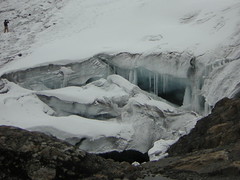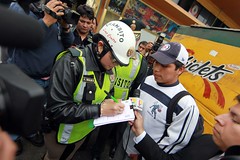Peru’s Firefighters
With a reckless disregard for their own well-being and a commendable regard for the well-being of others, Peru’s firefighters are nothing short of heroes. And it’s not just their physical health they put at risk, it’s their financial health too – Peru’s bomberos are all unpaid volunteers.

“Heroes” – Alexis Castro
Putting their lives on the line to put out fires, clear up hazardous materials, aid in natural disasters, and also rushing through the streets to bring the sick to hospitals, they do so following a 150 year tradition. Many brave citizens apply to enter a rigorous training program, a difficult course they must pay for with their own money. There they’ll learn how to put out fires, provide first aid and use specialised equipment. If they complete the program they enter a probation period where they have to prove they are capable of dealing with real-life emergencies. All but the best are let go.
Obviously their jobs are not easy, but in Peru things are made much worse for them.
Difficulties
Blocking the roads are Peru’s combis – mini-buses operated by thoughtless people who care more about turning a profit than the emergency the bomberos are trying to reach. Ordinary drivers are often just as incapable of rational thought, often not moving for the emergency vehicle behind them should it inconvenience them even slightly.
As greed clouds the small business owner’s mind, disasters such as the Mesa Redonda fire occur. Fire regulations are ignored, fire exits locked and laws broken. Illicit or faulty electricity connections cause many of Lima’s fires. The stupid cut costs and the innocent pay with their lives.
Hand-me-downs
In the course of saving the lives of a population that seems to be lacking appreciation, the bomberos have to put up with more still. Budgets are low in a country where the rich avoid tax and the working class feel they just don’t need to pay it. Fire brigades survive mostly on charity, both from home and abroad.
Huge amounts of the out-of-date equipment used are the hand-me-downs given to Peru from first-world countries like the United States. Although up to standards and well maintained when delivered, they can soon deteriorate when little money is spent on them. Equipment from the 80s and 90s, or even earlier, sometimes doesn’t fully meet modern needs.
One fire chief stated that a lack of adequate equipment and what they do have being 20 years old are the main problems Peru’s Volunteer Fire Department has. “We have certain deficiencies,” Chief Ferruzo states, “some of our units are using equipment from the 80’s.”
Progress
Hopes for the future though are improving. In 2006 things took a turn for the better for the brave bomberos. For the first time in the organisation’s history, the General Body of Voluntary Firemen in Peru, who oversee fire brigades on a national level, have been able to grant to their members life insurance and disability insurance.
Carlos Córdova, Chief Commander of Peru’s firefighters was visibly moved when he made the anouncement.
“Years of yearning are finally over. Today the alliance of solidarity and good will can harvest its fruits”.
The insurance policy issued by the Government-funded health service Essalud and covered by ‘Positiva Seguros y Reaseguros’ costs as much as $1000 a month per firefigher and will cover accidental death and total or partial permanent disability.
In 2008 the 48 million soles ($17m) Government contribution has been increased to 58 million soles ($20m) in an effort to improve equipment such as leaky hoses and protective clothing.
Brand new
No longer content with old donated rescue vehicles, earlier this year the region of Callao took delivery of six brand new firetrucks. At almost half a million dollars each, the ‘Contenders’ have a water capacity of 1,000 gallons and can carry an additional 100 gallons of fire-retardant foam. Callao now has some of the most modern equipment in the Americas.
A previous delivery of a number of new ambulances now makes the old port of Callao one of the best covered parts of the country.
While things slowly improve Peru’s bomberos carry on risking their lives as normal. Last year the volunteer firefighters had attended 120,000 emergencies throughout the country. In Lima, the bomberos had aided in a total of 81,967 emergencies from January to November of 2007. Out of these 81,967 cases, about 65 thousand had been medical emergencies while over five thousand had been fires.
Five thousand of the emergencies had been traffic accidents and 1,945 had been gas leak cases – yet more corners cut that these brave men and women much face.
Tags: callao, emergency, essalud, fire, firefighter, progress, tax










